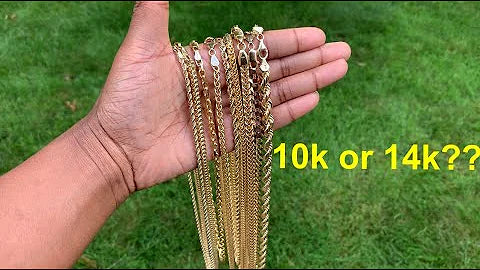When it comes to gold jewelry, there are a lot of decisions to make. What type of metal should you get? What color? How much should you spend? For many people, these decisions come down to whether they want 10k or 14k gold. But which one is the better choice for your needs?
Let’s take a look at the pros and cons of 10k vs 14k to help you make an informed decision.
10K Gold
10K gold is made up of 41.7% pure gold and 58.3% other metals such as copper, silver, nickel, zinc or palladium. It is the least expensive option in terms of cost per gram but also has the lowest purity level out of all types of gold jewelry.
The lower purity level means that 10K gold is not as soft or pliable as higher karats, so it may be more prone to scratches or dents over time. However, it does have a slightly higher resistance against oxidation compared to higher karats since its other metals are harder than pure gold and provide more protection against wear and tear.
Additionally, 10K gold typically has a richer yellow hue than 14K due to its higher concentration of copper.
14K Gold
14K gold is made up of 58.5% pure gold and 41.5% other metals such as copper, silver, nickel, zinc or palladium. While it will cost more per gram than 10K due to its higher purity level, it is still a popular choice among consumers because it offers greater pliability and flexibility than 10k while still being more affordable than 18k or 22k options.
Additionally, because 14k contains less copper than 10K jewelry does, its hue tends to be lighter with an almost white-gold appearance when polished properly.
Is 10K better than 14K?
When it comes to deciding between 10K and 14K gold, the choice is ultimately up to you. Both metals are durable and make beautiful jewelry pieces.
The main difference between the two is that 10K gold contains less pure gold than 14K gold – 10 parts out of 24 parts are pure gold, whereas 14 parts out of 24 parts are pure in 14k gold.
This means that 10K gold will be slightly more affordable since it contains less precious metal. However, if you’re looking for a longer-lasting piece then 14K might be your best option as it will have better durability due to its higher concentration of pure gold.
Ultimately, both options are excellent choices when looking for quality jewelry pieces.

Is 10K or 14K better for everyday wear?
When it comes to deciding between 10K or 14K gold for everyday wear, the best option depends on a few factors. 10K gold is known to be more durable and resistant to scratches, making it better suited for daily wear.
However, 14k contains more pure gold, which makes it softer and less resistant to damage. Ultimately, if you’re looking for a piece of jewelry that will last through regular wear and tear, 10K gold is the way to go.
On the other hand, if you want something of higher quality with a softer feel against your skin, 14K may be the better option for you. Both are excellent choices when selecting an item of fine jewelry for daily use!
Is 10k gold worth buying?
When it comes to buying gold, 10K gold is a popular choice for many people. 10K gold is more affordable than higher-karat gold jewelry and still offers the same beautiful shine.
Because of its lower cost, it’s an attractive option for those who want the look of real gold without breaking the bank. However, there are some drawbacks to consider with 10K gold jewelry. It is much less durable than higher-karat pieces and can easily scratch or bend if not properly cared for.
Additionally, because it’s only 41.7% pure gold, it tends to dull over time compared to 24K or 18K jewelry which maintains its luster longer. If you’re looking for something that will last a long time and retain its shine, you may want to opt for a higher-karat gold piece or consider other jewelry materials.
You can also read about 14k vs 18k gold here:
Is 10K more valuable than 14K?
When it comes to gold jewelry, the 10K vs 14K debate often arises. 10K gold is made of pure gold alloyed with other metals to make it more durable and pliable for use in jewelry such as rings or necklaces, while 14K gold is a higher quality alloy containing 58.5% pure gold and 41.5% other metals.
Ultimately, the choice between 10K and 14K comes down to personal preference; both options have their pros and cons.
While 10K is less expensive than its 14K counterpart, it may not last as long due to its lower purity levels. On the other hand, 14k has greater durability since it contains a higher amount of pure gold but also carries a heftier price tag.
Ultimately, the decision between 10K and 14K should be based on personal preference and budget. Both options are attractive and will make for beautiful pieces of jewelry that can last for many years to come. The choice is yours!
Which is better 10k or 14k?
Ultimately, choosing between 10k vs 14k gold depends on your preferences and budget constraints.
If you’re looking for something that’s more affordable but still looks nice enough for everyday wear then 10k might be the right choice for you; however, if money isn’t an issue then 14k would be the better option due to its greater durability and pleasing aesthetic appeal.
No matter which one you choose though you can rest assured knowing that either will provide years (if not decades) worth of enjoyment!



